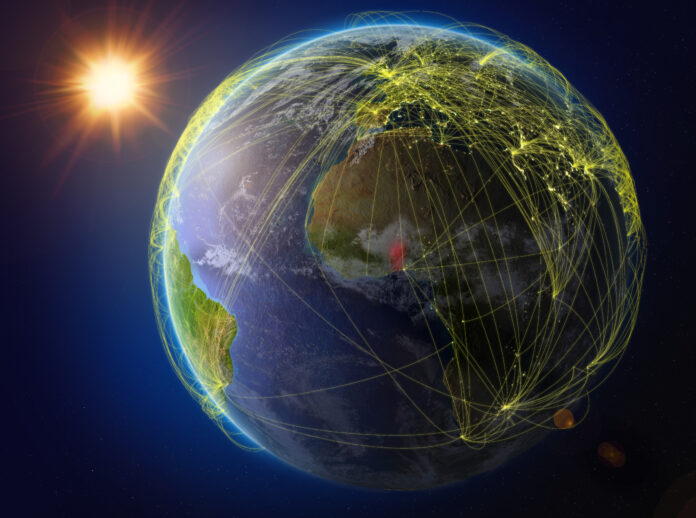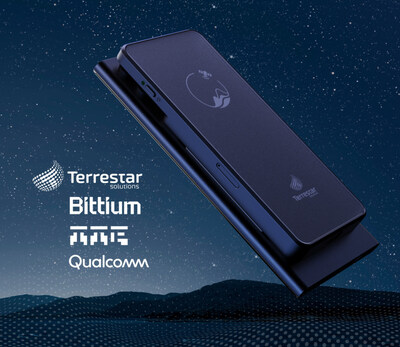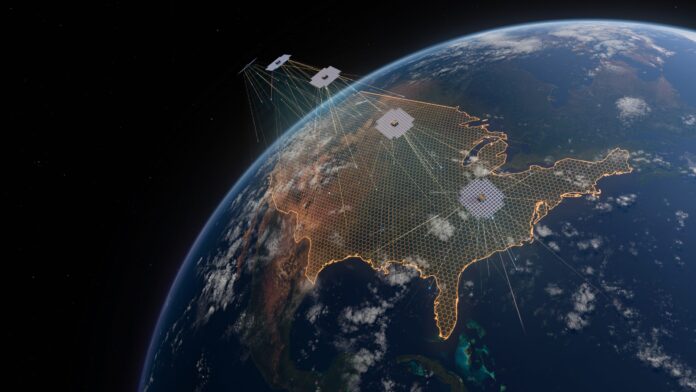Both the cellular and satellite industries are racing to be first in a new market of converged 5G Non-Terrestrial Network (NTN) services. 2025 is seeing an increase in both NTN-equipped satellite launches and service launches. Test vendors need to stay ahead of the challenging technical issues while playing the role of translator for two telecom verticals which don’t always speak the same language.
Three key takeaways:
– 2025 is seeing a flurry of activity as carriers and satellite providers around the world test and trial new, standards-based NTN services.
– Initial use cases are focusing on narrowband IoT for industry and emergency SMS for consumers, but the technology roadmap includes voice and data services as well.
– NTN scenarios add significant test complexity because of the satellite’s speed in relation to the planet, and Doppler shifts, delay, global position and attenuation all have to be accounted for or mitigated to ensure a successful service.

Which NB-NTN use case is the ‘juiciest’ for Viasat? The one with the longest sales cycle.
Mobile network operators and satellite operators striking partnerships and beginning to roll out satellite-based cellular services in hopes of capturing new revenues. Last month, Verizon boosted its direct-to-device texting capabilities on some Android phones,
While the many technical challenges of Non-Terrestrial Networks (NTN) are being addressed, there’s a larger question looming: How much of a market is there for these services, and is it a consumer or an enterprise market?
In a recent conversation at the 2025 Satellite Show, Andy Kessler, vice president for Viasat’s enterprise division, discussed the satellite operator’s views on the cellular NTN market with RCR Wireless News.
Viasat has an NB-IoT network that it markets as IoT Direct, which uses the company’s L-band satellite spectrum. In late March, Australian satellite IoT outfit Myriota launched its NB-NTN service, Myriota HyperPulse, using leased capacity from Viasat. Among its other recent deals related to cellular integration, Viasat also signed an MOU with United Arab Emirates-based Space42 last month to explore ecosystem partnerships for developing a 5G NTN in initiative, starting with technical and commercial studies on developing a “shared, or multi-tenant, multi-orbit 5G NTN infrastructure employing a standards-based open architecture” and using L-band, S-band and terrestrial spectrum.
Viasat, Kessler said, is targeting three different NB-NTN use cases. Those are:
Direct-to-consumer. This is the use case getting all the headlines these days: Using satellite-based connectivity with regular smartphones. NB-NTN is the tech underlying the few commercially available standards-based deployments that are out there right now, and more of NB-NTN-capable satellites are expected to be launched this year.
Kessler said that while that market is already developing through devices and carriers, he anticipates that “companion devices” will also be a part of the market.

At this year’s Mobile World Congress Barcelona, Terrestar Solutions, Bittium, TTP and Qualcomm Technologies demonstrated their Sat Companion prototype, which consisted of a slim, snap-on module with a high-gain antenna and Qualcomm 9205S modem inside—not all that dissimilar to the Motorola Z3’s “Moto Mod,” for those who remember the earliest attempts at 5G mmWave devices. The partners promised “seamless connectivity, providing users with uninterrupted SMS, chat, voice, and email services even in the most remote areas” with the Sat Companion device.
Kessler said that Viasat sees a “significant market” for such companion devices and expects there to be acceleration this year. He said that companion devices will enable not only SOS messages but satellite-based SMS more generally, given that Rel. 17 or later capabilities still rare. “So much of the ecosystem is not Release 17-capable. Even with the latest and greatest, it’s really only the flagship phones,” he noted, adding, “The companion device is a nice interim way to get services into the public without people having to sort of make a big leap on a new phone.”
After all, upgrades cycles for smartphones continue to lengthen, but companion devices could enable a wider segment of users to access satellite-based services even without upgrading their smartphone. “We really like the companion devices basically for that dynamic,” he said.
But Kessler doesn’t just see companion devices as a placeholder while waiting for an upgrade cycle to kick in. He anticipates that those type of devices will be a large segment of the direct-to-device consumer market for an extended time period. He also said that for off-grid adventurers, or people who want a back-up for when their phones’ battery dies or a phone is lost, satellite-based companion devices could also be developed that work for standalone, emergency connectivity—but would cost significantly less than the traditional satellite phone, because of the economies of scale that come from a standards-based ecosystem rather than a proprietary one.
“We think that’s a really good feature set to offer folks” so that people have the ability to reach out for help, Kessler said. “We think that’s going to be a big market for us.”
Industrial Internet of Things. “Industrial IoT is actually, I think, the most interesting in terms of how it’s going to change things,” Kessler said.
A survey-based report from Viasat earlier this year found that 85% of businesses said that they had “struggled to develop IoT because of connectivity issues in the areas they want to deploy.”
Fundamentally, he continued, the business case for NTN-based industrial IoT is about reducing barriers to entry. What that really comes down to, Kessler said—and what’s so exciting to the satellite industry and ecosystem right now—is the plummeting cost of compared to a traditional satellite user terminal, and which use cases would open for satellite connectivity as a result.
“We are already seeing strong evidence that we’re going to be able to have ecosystem partners. It truly is an ecosystem, that is going to be able to build and sell the hardware for tens of US dollars,” he said. “That reduction in terms of capital investment and barriers to entry, opens up all these use cases, which you never would have contemplated before.”

He comes back to an example that he jokingly says comes up in every meeting: Cattle tracking. If, say, a cow is worth somewhere between $1,000-$1,500 to a rancher, it doesn’t make sense to put $3,000 into using a satellite-based tracking device on that cow. “But if you can invest $50 to track a $1,500 cow, now all of a sudden that gets really interesting,” Kessler said. Such satellite tracking could, for example, help establish provenance and tracking of cattle so that they can be sold as boutique meats like 100% grass-fed.
How many more things do enterprises (and even consumers) own that cost a few thousand dollars and are therefore worth $50 or so to track? “Asset tracking in remote environments all of a sudden gets really important and really valuable when you can have that,” he said. “So we think of this as opening up all these untapped markets that fundamentally, the economics never made sense before. And now they will.”
Connected car. “Connected car might actually be the juiciest market for us, in terms of the magnitude of it and the opportunities that it presents,” Kessler reflected, adding that connected cars also present the opportunity to integrate a modem with a Rel. 17 or later chipset, as well as provide for a larger antenna that “opens up the possibilities in terms of what services you can deliver.”
Viasat was the first satellite provider to join the 5G Automotive Association, in late 2024. At the time, Kevin Kevin Cohen, VP of direct to device partnerships at Viasat, said: “With a longstanding history in providing critical safety services in the air and at sea, and our continued innovation on direct-to-device connectivity, joining the 5GAA is a natural fit for Viasat. By utilizing already licensed L-band spectrum for mobile satellite services, vehicles could roam between space and ground network connectivity.”
In early March, meanwhile, Viasat announced a first-of-its-kind demonstration of direct-to-device connectivity for the automotive sector, using Viasat’s L-band satellites and satellite NB-NTN provider Skylo’s network, to provide narrowband tracking, monitoring and messaging capabilities, using modules and antennas from Quectel Wireless Solutions that allowed test vehicles to ” seamlessly switch between satellite and cellular networks”. The trials took place over the last four months between Blumenau and Curitiba in southern Brazil, with tests conducted by Viasat partner GuardianSat through Acceleronix.
But the automotive NB-NTN use case has the longest sales cycle of the ones mentioned thus far. Which means, Kessler acknowledged, that it will be faster and easier to achieve noticeable progress on services and customers in the direct-to-consumer use case or in industrial IoT than in the connected car space.
Still, he said that Viasat is “pushing with all urgency on all three fronts.”
NTN: ‘It’s real,’ but the market is still just emerging
What’s the most important thing to understand about the satellite-cellular market right now?
“One of the key things is, it’s real,” Kessler said. “People can now do it. It’s gotten a year further down the maturity path. I have a Release 17-capable phone that I can roam onto satellite now.” More MNOs and MVNOs are recognizing the value of making satellite connectivity a part of their offerings, he added, forming relationships that look a lot like regular, terrestrial roaming arrangements. “There’s a lot of pull in the marketplace right now on that front, which I think gives us enhanced confidence that there really is a market for this,” Kessler said.
He expects the coming year to shed more light on utilization dynamics and how much people are willing to say—which, he acknowledges the ecosystem is “still in the market discovery” phase.
“I think what we will learn in the next year is fundamentally about those two points: about utilization [and] willingness to pay,” Kessler said—but he also reiterated that the market for NTN services is still in its early stages. No one company is likely to serve all the anticipated needs, but there are likely going to have to be strategic adjustments as the market features become clearer.
“This is certainly a period of market discovery right now,” Kessler said. “I would say we would be awfully naive to think that we have the perfectly suited approach in terms of go-to-market right now. So, what we’re fundamentally about is, as we learn, we’re going to recognize where we need to adapt, and it’s likely to change in some way.”

Four market predictions for 5G NTN (and four phases of direct-to-cellular)
With both the satellite industry and the cellular industry trying to figure out which use cases, services and business models should shape their approach to converged 5G Non-Terrestrial Networks (NTN), what do analysts have to say about the market opportunity?
There have already been a number of notable developments in the 5G NTN market over the past two years, from Apple’s deal with GlobalStar to support the smartphone maker’s direct-to-device emergency service offering, to Qualcomm pulling out of a deal with Iridium to develop an NTN chipset that would have only worked with Iridium’s proprietary network.
Here are four takes from analyst firms on the 5G NTN market, including one that looks specifically at the direct-to-device opportunity and how it is likely to evolve.
-ABI Research has predicted that there will be $124.6 billion worth of annual service revenues from satellites by 2030 and that the specific NTN-Mobile segment “has the potential to reach a market value of around $18 billion with up to 200 million connections by 2031.”
“The emergence of satellite-enabled mobile devices from major consumer smartphone manufacturers and chipset makers like Apple, Qualcomm, Motorola, MediaTek, Huawei, and ZTE indicates satellite communications services breaking into the mainstream consumer market,” said Andrew Cavalier, satellite communications industry analyst at ABI Research, who also added that “The possibilities for global IoT connectivity have expanded, driving further innovation in the satellite industry.”
“We are seeing that the market is evolving quickly, and many services are finding enhanced deployment through strategic alliances and from increased bandwidth supply in LEO,” added Jake Saunders, VP of Asia Pacific at ABI Research. “With satellites becoming smaller, more affordable, and reaching closer orbits, the barriers to entry have been lowered, fostering innovation and expanding the scope of satellite-based services and applications. The market is revealing new development paths that will influence the Terrestrial and Non-terrestrial connectivity markets and shape enterprise opportunities throughout the telecommunications value chain.”
-Market analysis firm Lucintel released a report in January 2024 on its forecasts for the 5G NTN market, saying that the future of the market “looks promising” with opportunities anticipated in the maritime, aerospace, defense, government and mining markets. The firm predicts that the 5G NTN market will reach $27.7 billion by 2030, with a compound annual growth rate of more than 33% from 2024 to 2030.
Lucintel expects the maritime market to have the highest rate of growth “due to multitude of applications and services are possible on board yachts” and the seamless connectivity and high data rates that are expected from 5G NTN. In terms of regions, North America is expected to see the highest growth rate.
-Global Market Insights pegs the 5G NTN market at about $4.2 billion as of 2023 and expects a CAGR of 35% through 2032, with the market reaching nearly $80 billion at the end of the forecast period. The firm cites “increasing demand for ubiquitous and high speed connectivity worldwide” as the driving factor for the market. Aerospace and defense uses account for an estimated 35% of the market, with maritime, government and mining constituting the other major market segments. 5G NTN will be “a crucial enabler for innovation and efficiency in the aerospace and defense domain,” the firm concludes, with 5G NTN offering “enhanced data transmission, improved reliability and extended coverage” that align with aerospace and defense operational needs and the ability to support autonomous systems including UAVs, remote sensing and mission-critical communications. GMI also sees North America as the dominant region for the 5G NTN market at this time.
-NSR (which is part of Analysys Mason and focuses on the satellite market) expects that NTN revenue for telcos is set to grow by USD32.5 billion between 2022 and 2027, according to forecasts produced as part of Analysys Mason’s Satellite Strategies for Telcos program.
However, in a March 2024 blog post on the direct-to-device opportunity, NSR Principal Analyst Lluc Palerm laid out four distinct phases for the D2D market—and not all of them are particularly profitable, especially in the near-term. Palerm says that “the direct revenue opportunity in the early years [of NTN D2C] is low,” and notes that currently available systems limit offerings to basic emergency alerts and messaging.
For systems that use pre-Rel. 17 technology, “the amount of bandwidth available is not big enough to support advanced voice and data services direct to unmodified phones at scale,” he concludes—and adds that even for companies that plan to use terrestrial spectrum from space for direct-to-device offerings that are compatible with existing phones, “the early offerings of these constellations will also be limited to emergency alerts and messaging.”
That’s a tough situation, because he goes on to say that “the willingness of mainstream users to pay for emergency alerts and messaging services is limited.” Analysys Mason predicts that the potential revenue for NTN-based emergency alerts will be less than $100 million globally through 2032. Revenue from direct-to-device messaging is expected to be only a bit higher at $500 million globally. Instead, NTN emergency services are expected to be a service differentiator for competitive purposes. “The direct revenue opportunity might not be significant for mobile network operators (MNOs), but end users value these potentially lifesaving features. MNOs should focus on incorporating these satellite D2D services as a differentiator from competitors,” he wrote.
But the outlook isn’t entirely without hope of revenue—Palerm thinks the much more substantial revenue opportunity will come with voice and broadband data. When those become available via NTN, “a vast and accessible market will emerge” consisting of “demand from recreational travellers, rural residents, IoT, first responders and many others who want to stay connected when out of the reach of the limited terrestrial network coverage will boost market penetration and adoption rates. Huge revenue opportunities await when coverage is worldwide, connections are reliable and data speeds are consistent.”
However, this will mean that far more satellites will have to be launched in order to scale voice and data services. As telcos think about partnerships in this arena, Palerm points out that they have to make important decisions about spectrum strategies (terrestrial or MSS? Which frequencies and how much spectrum to dedicate, in which areas?), proprietary vs. standardized solutions and whether they will serve consumers or enterprise/industrial IoT.
“Successful partnerships will probably be those that acknowledge the importance of the members of the value chain, and those that can coordinate and garner support from players across the value chain,” he writes.

‘We have lift-off!’ One NZ launches first nationwide D2C texting service with Starlink
The direct-to-cellular or D2C texting service is available on four smartphones, free of charge for eligible users
One New Zealand has become the first carrier to launch a nationwide satellite-based direct-to-cellular, or D2C, texting service to its customers, relying on Starlink’s Low Earth Orbit satellites.
“We have lift-off! I’m incredibly proud that One NZ is the first telecommunications company globally to launch a nationwide Starlink Direct to Mobile service, and One NZ customers are among the first in the world to begin using this groundbreaking technology,” said Joe Goddard, experience and commercial director at One NZ, in a statement.
The only other time that the service has been used was a temporary period this past fall, when Starlink and T-Mobile US got special permission to activate it for users as part of hurricane response in the United States. (T-Mobile US opened registration this week for its D2C texting beta service, which will kick off in 2025.)
Goddard said that in addition to covering New Zealand and the 40% of its landmass that isn’t covered by terrestrial mobile networks, the D2C texting service also works along the coasts, to a distance of about 20 kilometers out to sea.
One NZ said that eligible customers with one of four devices—the Samsung Galaxy Z Flip6, Samsung Galaxy Z Fold6, Samsung Galaxy S24 Ultra and OPPO Find X8 Pro—would be notified that they can start using the service, which is being offered on specific One NZ plans free of charge. The carrier said that eligible devices would be expanding over the course of 2025; according to a FAQ on the service, devices in testing include other S24, S23 and S22 models and a range of other Samsung devices, and several Oppo Reno12 models are in testing. No Apple devices were listed as eligible for the service.
Accessing the satellite-to-cellular service requires clear line-of-sight to the sky, and One NZ warned that D2C texting will take longer than with terrestrial cellular connectivity.
“One NZ testing indicates in many cases during the initial rollout period, text messages will be sent and received within 3 minutes,” the carrier said in a release. “However, at times it may take 10 minutes or longer to send and receive a text message via satellite, especially during the first few months. As the service matures and more satellites are launched, we expect text messages to take a minute on average to be delivered via space.”
The carrier said that the type of phone, the user’s geographic location, and whether a Starlink satellite is currently overhead or not, all influence whether, and how long it takes, for the D2C text to be sent or received.
The company added: “We continue to test the capabilities of One NZ Satellite TXT, and this is an initial service that will get better.”
“This is a generational change in mobile technology, just like 4G or 5G,” Goddard said. “Not only will you be able to message family and friends from parts of our beautiful country that you never thought possible, but soon this will open up new opportunities in IoT (Internet of Things) for sectors like agriculture, tourism, logistics and many more that power our economy here in NZ.” Goddard also framed the service as potentially providing “another layer of resilience in public emergencies”.
One NZ showcased the D2C texting technology with help from George Hillary, Sir Edmund Hillary’s grandson (pictured at top), who sent a text to his brother Alex Hillary, GM of the Himalayan Trust, from the top of Mount Head, a remote peak in New Zealand’s Forbes Mountains.
George Hillary commented: “The potential of this technology is mind-blowing. I’m used to being pretty limited from a communications perspective when hiking or on an adventure. I always take an emergency beacon in case things go wrong, but now also having the ability to send and receive text messages is huge. I can contact a friend for help or give climbing updates to my family while away.”
Goddard said: “For New Zealanders who like getting out into our great outdoors – or for people who need to travel along state highways and beyond for work – the reality is that many parts of the country lack traditional mobile coverage. … Our teams continue to test the service on additional phones, and we expect hundreds of thousands of customers to be able to use One NZ Satellite TXT by the end of 2025.”

AST SpaceMobile supported live NTN video calls for Verizon, AT&T via its new Bluebird LEO satellites
Verizon said that it has successfully completed its first Non-Terrestrial Network (NTN) live video call between a device on its terrestrial cellular network and one connected via an AST SpaceMobile satellite.
Meanwhile, AT&T also announced this morning that AST has supported another video call over its network via a regular smartphone. The carrier said that nearly half of AT&T customers already have access to peer-to-peer messaging and emergency satellite services.
AT&T did its first video call with AST in June of 2023, prior to the launch of AST’s newest satellites. This time, AST SpaceMobile initiated the live NTN video call from Midland, Texas, according to AT&T, which called it “one small step for man, but one giant connection for mankind.”
Hans Vestberg, chairman and CEO of Verizon, commented on Verizon’s NTN video call, saying: “This breakthrough marks a new era in cellular to satellite connectivity in the United States that enables seamless data transmissions – not just texts – in the rare instance a terrestrial cellular network is not available. Adding this layer of ability—not only to text someone, but to be able to call, video chat, or send files—whether in the wilderness, or in a remote part of a lake community, will only enhance the reliability of our customers’ connectivity and communication experience.”
Other cellular network providers and device manufacturers including T-Mobile US, Vodafone, Apple and Google have been testing and prepping new NTN services in the past few months, with some options set to go commercial this year. (T-Mobile US just launched its beta NTN service with Starlink earlier this month.)
In addition to being a customer of, and investor in, AST SpaceMobile, Verizon also has a relationship with NTN connectivity provider Skylo for satellite-based, direct-to-device messaging outside of its network footprint. (Verizon and Skylo are also researching the development of satellite IoT technology and have conducted a proof-of-concept demonstrating the roaming capability of a Verizon-enabled IoT cellular device across both the mobile carrier’s cellular network and Skylo’s satellite network.)
“Our team has worked tirelessly to develop a satellite to device data connection for consumers to power their lives,” said Joe Russo, EVP and president of global network and technology for Verizon. “We are relentlessly focused on providing the most reliable network experience for our customers where they live, work and play, and providing this added layer of reliability is another reason our customers trust us to keep them connected wherever life takes them.”
AST SpaceMobile received permission from the Federal Communications Commission earlier this month to begin testing of its five new Bluebird satellites in low Earth orbit (LEO), which were launched in October 2024. The satellites, whose beams are designed to support a capacity of up to 40 MHz and deliver peak data transmission speeds of up to 120 Mbps, are expected to support non-continuous cellular broadband service across parts of the U.S. and are compatible with unmodified AT&T and Verizon smartphones.
AST SpaceMobile has said previously that the goal is to provide approximately 100% nationwide coverage from space with more than 5,600 coverage cells. The company is working with both Verizon and AT&T in the United States. Verizon has made a $100 million commitment to AST SpaceMobile, which comprises $65 million in commercial prepayments plus $35 million of convertible notes, plus use of the company’s 850 MHz spectrum.
In related news, Vodafone—another investor and customer of AST SpaceMobile—last week announced a research hub dedicated to the enablement of seamless switching between LEO space-based and land mobile broadband services. The project is supported by an initial grant from the Spanish Space Agency, and the telco has tapped AST SpaceMobile and the University of Málaga (UMA) as lead partners, with other third-party technology companies and developers invited to join.
The emphasis for the hub will be on the design, testing and validation of new, open source hardware, software and processing chips that can work interchangeably in both space and terrestrial networks, Vodafone noted, adding that it will be home to space-to-land gateway, like the one the telco used for its January space direct-to-device video call, an achievement it called a world-first. Vodafone’s partners, as well as other operators, will be able to use this gateway to test and validate their own services connected to AST SpaceMobile’s BlueBird satellites before introducing them to the market.

Lynk, Turkcell test satellite direct-to-device
Satellite company Lynk Global said that it has successfully demonstrated its patented direct-to-device technology in tests conducted in Türkiye with mobile network operator Turkcell.
Turkcell is Türkiye’s largest mobile operator and has more than 40 million subscribers. The two companies signed an agreement in February 2024 to collaborate on direct-to-device, or direct-to-cellular (D2C), connectivity for the Turkcell network, in order to both expand mobile coverage and provide additional network resilience.
The field tests for SMS, voice and mobile data were conducted with standard mobile phones near the city of Konya, Türkiye, in a rural area, according to Lynk. The tests used Turkcell terrestrial spectrum and Lynk’s satellites “to successfully provide seamless SMS exchanges and voice calls using commercial cell phones without requiring specialized devices or attachments,” Lynk said in a release.
Ramu Potarazu, CEO of Lynk, said that together with Turkcell, Lynk is “is committed to enhancing connectivity across rural areas in Türkiye, including in emergencies when terrestrial networks are temporarily inoperable.”
Lynk says that it has tested its technology successfully on all seven continents, and that it has 50 mobile network operator partners around the world as well as commercial contracts to deliver services to roughly 60 countries.
Lynk struck a deal with satellite provider SES earlier this year in which SES agreed to provide Series B funding for Lynk Global’s growing satellite constellation and offer integrated services to enhance network capabilities.
In September 2022, Lynk was given operating approval from the Federal Communications Commission (FCC) for a total of 10 low Earth orbit (LEO) satellites in order to provide connectivity to existing GSM and LTE devices outside the U.S., via partnerships with MNOs rather than as a direct-to-consumer service. The company has permission to operate in bands ranging from 617-960 MHz (space to Earth transmissions) and 663-915 MHz (Earth-to-space) with earth stations outside the United States, as well as tracking and control at 20 and 30 GHz and in the 2 GHz band.
The announcement by Lynk Global and Turkcell follows recent announcements by Verizon that it has begun device software upgrades to some Samsung Galaxy S25 and Google Pixel 9 smartphones, to enable Non-Terrestrial Network (NTN) D2C texting capability using NTN provider Skylo.
Charter and Comcast, which provide wireless service via the Spectrum Mobile and Xfinity Mobile mobile virtual network operators (MVNOs) on the Verizon network, also have launched satellite-based emergency messaging via Skylo.
“The availability of satellite backup service provides Spectrum Mobile customers with a sense of security, knowing they can stay connected even in the most remote locations,” said Charter’s EVP of Product Danny Bowman. “We are delivering cutting-edge technology that continues to empower our customers with the confidence that their communication needs are always met, no matter where they are.”
